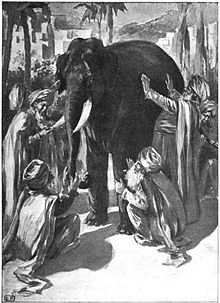
Back رجال عميان وفيل Arabic অন্ধের হস্তি দর্শন Bengali/Bangla Els cecs i l'elefant Catalan Die blinden Männer und der Elefant German Blinduloj kaj elefanto Esperanto Los ciegos y el elefante Spanish فیل و کوران Persian Sokeat miehet ja elefantti Finnish Les Aveugles et l'Éléphant French העיוורים והפיל HE


The parable of the blind men and an elephant is a story of a group of blind men who have never come across an elephant before and who learn and imagine what the elephant is like by touching it. Each blind man feels a different part of the animal's body, but only one part, such as the side or the tusk. They then describe the animal based on their limited experience and their descriptions of the elephant are different from each other. In some versions, they come to suspect that the other person is dishonest and they come to blows. The moral of the parable is that humans have a tendency to claim absolute truth based on their limited, subjective experience as they ignore other people's limited, subjective experiences which may be equally true.[1][2] The parable originated in the ancient Indian subcontinent, from where it has been widely diffused.
The Buddhist text Tittha Sutta, Udāna 6.4, Khuddaka Nikaya,[3] contains one of the earliest versions of the story. The Tittha Sutta is dated to around c. 500 BCE, during the lifetime of the Buddha.[4] Other versions of the parable describes sighted men encountering a large statue on a dark night, or some other large object while blindfolded.
In its various versions, it is a parable that has crossed between many religious traditions and is part of Jain, Hindu and Buddhist texts of 1st millennium CE or before.[5][4] The story also appears in 2nd millennium Sufi and Baháʼí Faith lore. The tale later became well known in Europe, with 19th-century American poet John Godfrey Saxe creating his own version as a poem, with a final verse that explains that the elephant is a metaphor for God, and the various blind men represent religions that disagree on something no one has fully experienced.[6] The story has been published in many books for adults and children, and interpreted in a variety of ways.
- ^ E. Bruce Goldstein (2010). Encyclopedia of Perception. SAGE Publications. p. 492. ISBN 978-1-4129-4081-8., Quote: The ancient Hindu parable of the six blind men and the elephant...."
- ^ Cite error: The named reference
snyder12was invoked but never defined (see the help page). - ^ "Ud 6:4 Sectarians (1) (Tittha Sutta)". suttacentral.net. Retrieved 17 December 2021.
This site offers a non-sectarian correspondence index of early Buddhist texts in all available language recensions, with multiple translations.
- ^ a b John D. Ireland (2007). Udana and the Itivuttaka: Two Classics from the Pali Canon. Buddhist Publication Society. pp. 9, 81–84. ISBN 978-955-24-0164-0.
- ^ Paul J. Griffiths (2007). An Apology for Apologetics: A Study in the Logic of Interreligious Dialogue. Wipf and Stock. pp. 46–47. ISBN 978-1-55635-731-2.
- ^ Martin Gardner (1 September 1995). Famous Poems from Bygone Days. Courier Dover Publications. p. 124. ISBN 978-0-486-28623-5. Retrieved 25 August 2012.
© MMXXIII Rich X Search. We shall prevail. All rights reserved. Rich X Search